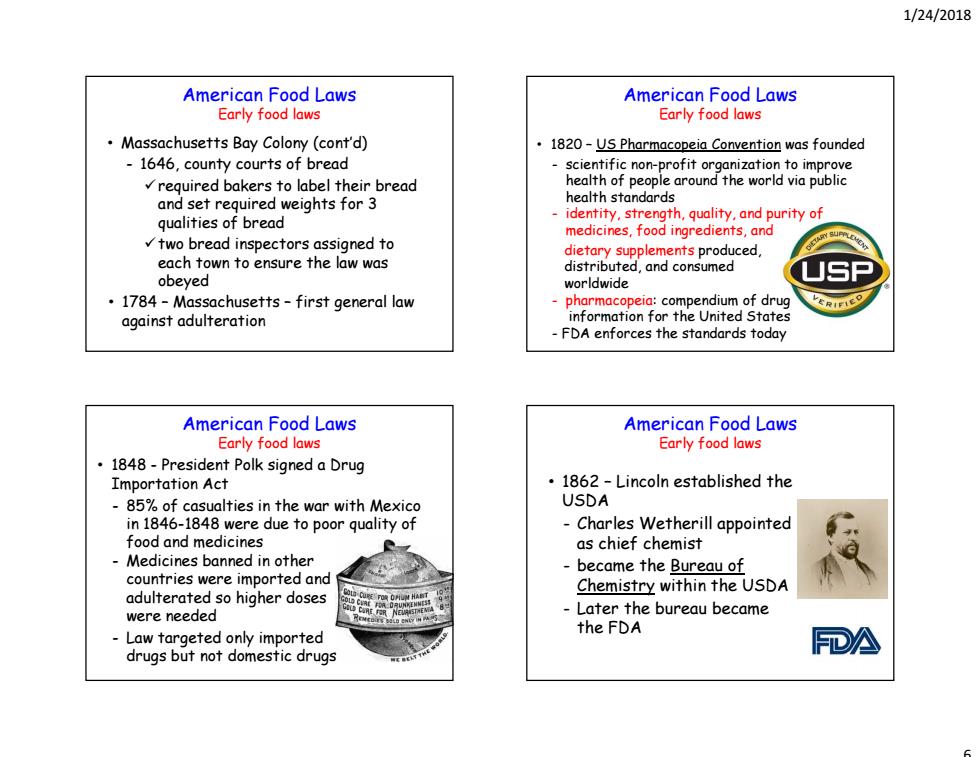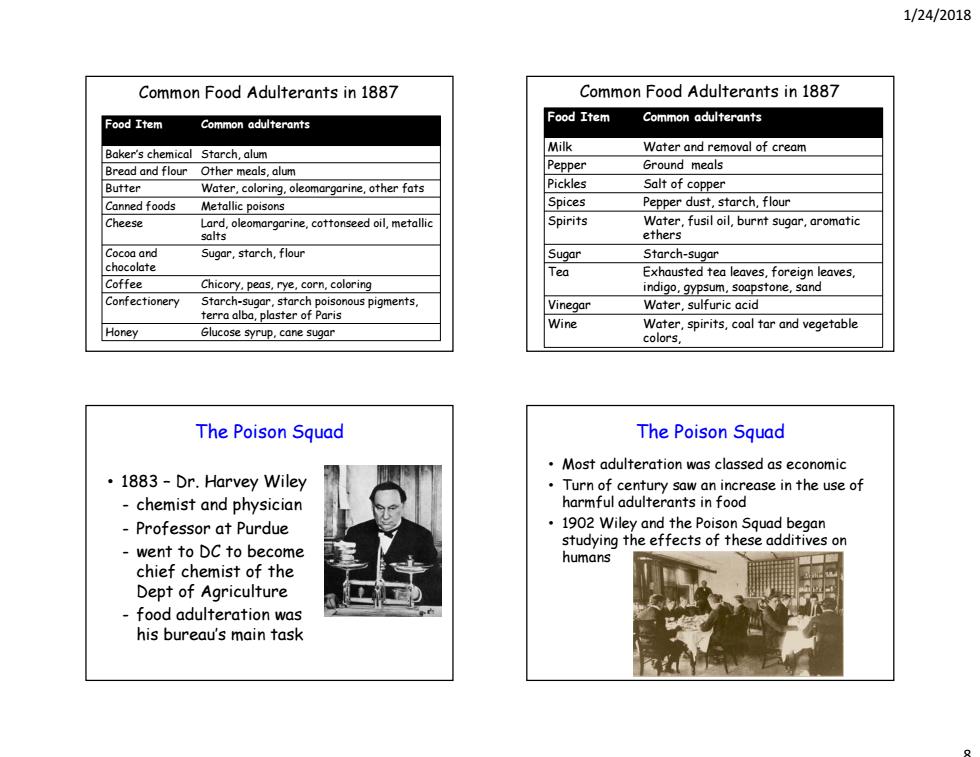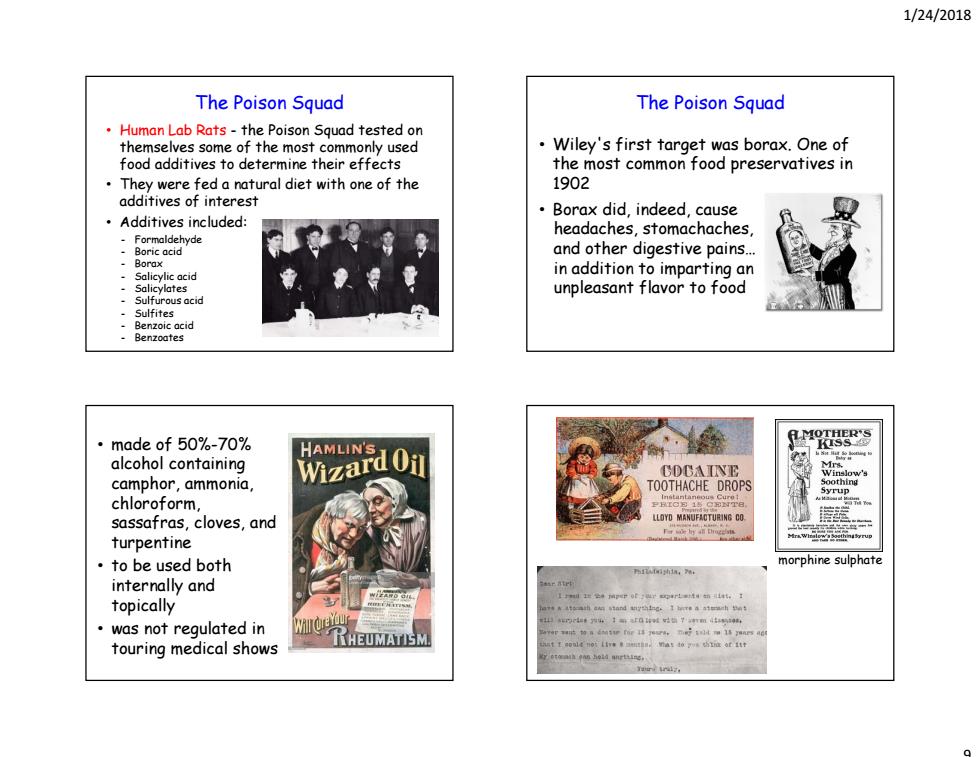
1/24/2018 American Food Laws American Food Laws Early food laws Early food laws Massachusetts Bay Colony (cont'd) 1820-US Pharmacopeia Convention was founded -1646,county courts of bread scientific non-profit organization to improve required bakers to label their bread health of people around the world via public and set required weights for 3 health standards qualities of bread identity.strength,quality,and purity of medicines,food ingredients,and Y SU two bread inspectors assigned to dietary supplements produced, each town to ensure the law was distributed,and consumed obeyed worldwide SP 1784-Massachusetts-first general law pharmacopeia:compendium of drug against adulteration information for the United States FDA enforces the standards today American Food Laws American Food Laws Early food laws Early food laws 1848-President Polk signed a Drug Importation Act 1862-Lincoln established the 85%of casualties in the war with Mexico USDA in 1846-1848 were due to poor quality of -Charles Wetherill appointed food and medicines as chief chemist Medicines banned in other became the Bureau of countries were imported and Chemistry within the USDA adulterated so higher doses were needed Later the bureau became the FDA Law targeted only imported drugs but not domestic drugs FDA
1/24/2018 6 • Massachusetts Bay Colony (cont’d) - 1646, county courts of bread required bakers to label their bread and set required weights for 3 qualities of bread two bread inspectors assigned to each town to ensure the law was obeyed • 1784 – Massachusetts – first general law against adulteration American Food Laws Early food laws • 1820 – US Pharmacopeia Convention was founded - scientific non-profit organization to improve health of people around the world via public health standards - identity, strength, quality, and purity of medicines, food ingredients, and dietary supplements produced, distributed, and consumed worldwide - pharmacopeia: compendium of drug information for the United States - FDA enforces the standards today American Food Laws Early food laws • 1848 - President Polk signed a Drug Importation Act - 85% of casualties in the war with Mexico in 1846-1848 were due to poor quality of food and medicines - Medicines banned in other countries were imported and adulterated so higher doses were needed - Law targeted only imported drugs but not domestic drugs American Food Laws Early food laws • 1862 – Lincoln established the USDA - Charles Wetherill appointed as chief chemist - became the Bureau of Chemistry within the USDA - Later the bureau became the FDA American Food Laws Early food laws

1/24/2018 American Food Laws American Food Laws Early food laws Early food laws The US became more urban and industrialized 1880-Chief chemist of the USDA, -marketplaces were developed to purchase food Peter Collier adulteration became a bigger problem to meet -Recommended a national food and drug the demand law technology led to new ingredients and Americans felt food regulation was a products that were not safe state issue and a federal issue economic and unsafe adulteration was a Then as today,federal agencies problem (executive branch)cannot regulate food states had laws dealing with adulteration but industry until Congress(legislative these laws did not apply to interstate branch)authorizes the agency to do so commerce Only recommendations can be made American Food Laws American Food Laws Early food laws Early food laws 1877-State Boards of Health Level of adulteration in New york in 1882 formulated laws against adulteration Item -Published statistics on adulteration in Butter 40 21 52.5 the food supply Olive oil 16 9 56.3 Difficulties occurred in enforcing the Baking powder 84 8 9.5 117 law due to lack of explicit details in the Flour 8 6.8 Spices 180 112 62.2 law Coffee (ground)21 19 90.5 State enacted laws provide too much Candy (yellow)10 > 70.0 variation in laws between states Brandy 25 16 64.0 4 60
1/24/2018 7 • The US became more urban and industrialized - marketplaces were developed to purchase food - adulteration became a bigger problem to meet the demand - technology led to new ingredients and products that were not safe - economic and unsafe adulteration was a problem - states had laws dealing with adulteration but these laws did not apply to interstate commerce American Food Laws Early food laws • 1880 – Chief chemist of the USDA, Peter Collier - Recommended a national food and drug law - Americans felt food regulation was a state issue and a federal issue • Then as today, federal agencies (executive branch) cannot regulate food industry until Congress (legislative branch) authorizes the agency to do so • Only recommendations can be made American Food Laws Early food laws • 1877 – State Boards of Health formulated laws against adulteration - Published statistics on adulteration in the food supply - Difficulties occurred in enforcing the law due to lack of explicit details in the law - State enacted laws provide too much variation in laws between states American Food Laws Early food laws Item # samples tested # found to be adulterated Percent adulterated Butter 40 21 52.5 Olive oil 16 9 56.3 Baking powder 84 8 9.5 Flour 117 8 6.8 Spices 180 112 62.2 Coffee (ground) 21 19 90.5 Candy (yellow) 10 7 70.0 Brandy 25 16 64.0 Sugar 67 4 6.0 American Food Laws Early food laws Level of adulteration in New York in 1882

1/24/2018 Common Food Adulterants in 1887 Common Food Adulterants in 1887 Food Item Common adulterants Food Item Common adulterants Baker's chemical Starch,alum Milk Water and removal of cream Bread and flour Other meals,alum Pepper Ground meals Butter Water,coloring.oleomargarine,other fats Pickles Salt of copper Canned foods Metallic poisons Spices Pepper dust,starch,flour Cheese Lard,oleomargarine.cottonseed oil,metallic Spirits Water,fusil oil,burnt sugar,aromatic salts ethers Cocoa and Sugar,starch,flour Sugar Starch-sugar chocolate Tea Exhausted tea leaves,foreign leaves, Coffee Chicory.peas,rye,corn,coloring indigo,gypsum,soapstone,sand Confectionery Starch-sugar,starch poisonous pigments, Vinegar Water,sulfuric acid terra alba,plaster of Paris Wine Honey Glucose syrup,cane sugar Water,spirits,coal tar and vegetable colors, The Poison Squad The Poison Squad Most adulteration was classed as economic 1883-Dr.Harvey Wiley Turn of century saw an increase in the use of -chemist and physician harmful adulterants in food -Professor at Purdue 1902 Wiley and the Poison Squad began studying the effects of these additives on -went to DC to become humans chief chemist of the Dept of Agriculture food adulteration was his bureau's main task
1/24/2018 8 Food Item Common adulterants Baker’s chemical Starch, alum Bread and flour Other meals, alum Butter Water, coloring, oleomargarine, other fats Canned foods Metallic poisons Cheese Lard, oleomargarine, cottonseed oil, metallic salts Cocoa and chocolate Sugar, starch, flour Coffee Chicory, peas, rye, corn, coloring Confectionery Starch-sugar, starch poisonous pigments, terra alba, plaster of Paris Honey Glucose syrup, cane sugar Common Food Adulterants in 1887 Food Item Common adulterants Milk Water and removal of cream Pepper Ground meals Pickles Salt of copper Spices Pepper dust, starch, flour Spirits Water, fusil oil, burnt sugar, aromatic ethers Sugar Starch-sugar Tea Exhausted tea leaves, foreign leaves, indigo, gypsum, soapstone, sand Vinegar Water, sulfuric acid Wine Water, spirits, coal tar and vegetable colors, Common Food Adulterants in 1887 • 1883 – Dr. Harvey Wiley - chemist and physician - Professor at Purdue - went to DC to become chief chemist of the Dept of Agriculture - food adulteration was his bureau’s main task The Poison Squad • Most adulteration was classed as economic • Turn of century saw an increase in the use of harmful adulterants in food • 1902 Wiley and the Poison Squad began studying the effects of these additives on humans The Poison Squad

1/24/2018 The Poison Squad The Poison Squad Human Lab Rats-the Poison Squad tested on themselves some of the most commonly used Wiley's first target was borax.One of food additives to determine their effects the most common food preservatives in They were fed a natural diet with one of the 1902 additives of interest Borax did,indeed,cause ·Additives included: headaches,stomachaches, Formaldehyde 、 Boric acid and other digestive pains. Borax Salicylic acid in addition to imparting an Salicylates unpleasant flavor to food Sulfurous acid Sulfites cid ·made of50%-70% alcohol containing COCAINE camphor,ammonia TOOTHACHE DROPS chloroform sassafras,cloves,and LLOYD MANUFACTURING CO. turpentine ·to be used both morphine sulphate internally and topically ·was not regulated in touring medical shows
1/24/2018 9 • Human Lab Rats - the Poison Squad tested on themselves some of the most commonly used food additives to determine their effects • They were fed a natural diet with one of the additives of interest • Additives included: - Formaldehyde - Boric acid - Borax - Salicylic acid - Salicylates - Sulfurous acid - Sulfites - Benzoic acid - Benzoates The Poison Squad • Wiley's first target was borax. One of the most common food preservatives in 1902 • Borax did, indeed, cause headaches, stomachaches, and other digestive pains… in addition to imparting an unpleasant flavor to food The Poison Squad • made of 50%-70% alcohol containing camphor, ammonia, chloroform, sassafras, cloves, and turpentine • to be used both internally and topically • was not regulated in touring medical shows morphine sulphate